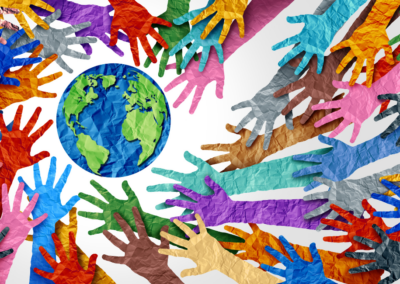Understanding Prejudice Reduction and Collective Action in Anti-Bias Education
Welcome to Week 2 of our exploration into Learning for Justice’s Social Justice Standards. This week, we delve deeper into the framework to understand two pivotal concepts in anti-bias education: prejudice reduction and collective action. Our objectives are:
- To distinguish between prejudice reduction and collective action.
- To explore why anti-bias education has often prioritized prejudice reduction.
- To examine the importance of integrating collective action into anti-bias education.
A guiding quote by Marian Adams frames this week’s discussion:
“Without truly valuing diversity, we cannot effectively address issues of injustice. Without addressing issues of injustice, we cannot truly value diversity.”
Key Terms: In-Group, Out-Group, Prejudice Reduction, and Collective Action
In-Group and Out-Group
- In-Group: A group an individual psychologically identifies with.
- Out-Group: A group an individual does not identify with.
These groups are contextual and shift based on circumstances. For example, a white woman advocating for women’s equal pay may be in the in-group. However, if she supports equal pay for Black and white workers, she moves into the out-group within that specific context.
Prejudice Reduction
Prejudice reduction focuses on breaking down stereotypes that foster adversarial views and bias. It aligns with the Identity and Diversity domains of the Social Justice Standards. Activities such as diversity celebrations or “World Culture Day” often fall under this category, aiming to create understanding and reduce conflict.
Collective Action
Collective action is the coordinated effort of marginalized or oppressed groups demanding justice and equality. It corresponds to the Justice and Action domains of the Social Justice Standards. Examples include organized protests, student walkouts, and campaigns advocating for systemic change.
Contrasting Prejudice Reduction and Collective Action
| Prejudice Reduction | Collective Action |
| Seeks to minimize conflict. | Challenges inequality directly. |
| Focuses on changing in-group attitudes. | Focuses on improving conditions for marginalized groups. |
| Downplays individual identities. | Highlights individual and group identities. |
| Encourages crossing group boundaries. | Strengthens impermeable group boundaries. |
Both approaches are vital for today’s diverse classrooms, as they address different aspects of anti-bias education.
Examples of Prejudice Reduction and Collective Action
- Prejudice Reduction
- Activity: Mix It Up at Lunch Day
Students are encouraged to eat and interact with peers they wouldn’t usually engage with. This activity fosters inclusivity and breaks down stereotypes, but individual identities become less noticeable as group boundaries are crossed.
- Activity: Mix It Up at Lunch Day
- Collective Action
- Event: Student Walkout to Support DREAMers
This protest highlights the plight of DREAMers and demands systemic change, such as the renewal of DACA. Here, individual identities and group solidarity take center stage, emphasizing collective identification within the marginalized group.
- Event: Student Walkout to Support DREAMers
Discussion Prompts
To deepen your understanding, engage in two activities this week:
- Your Practices:
Reflect on the activities you already use in your teaching or community work. Which align with prejudice reduction? Which embody collective action? Are there any overlaps? Share your examples with the educator community if you’re comfortable. - Social Movements:
Analyze a social movement such as #MeToo, Black Lives Matter, or Take a Knee. Is it an example of collective action? What prejudice reduction efforts could help address the root causes of this movement?
Moving Forward
By understanding the roles of prejudice reduction and collective action, we can create learning environments that both reduce conflict and demand systemic change. Anti-bias education is most effective when it balances these complementary approaches, fostering empathy while empowering marginalized voices.
Let’s continue to build classrooms and communities where justice and equality are achievable goals for all.




















